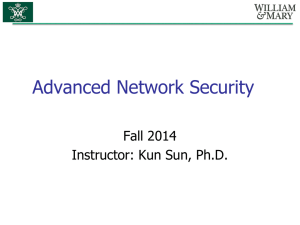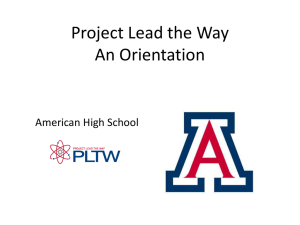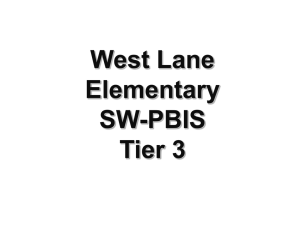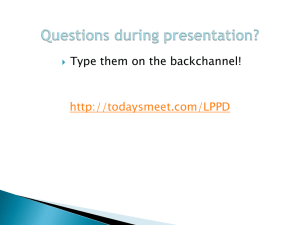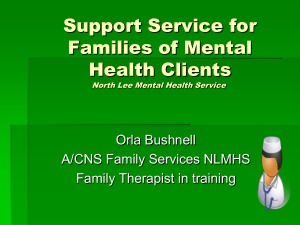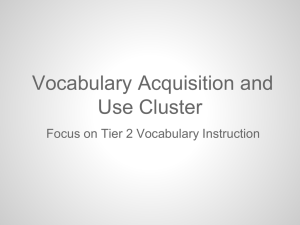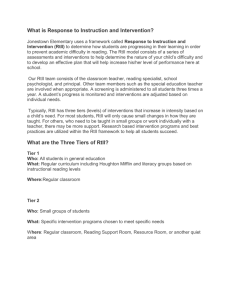What is Study Island?
advertisement
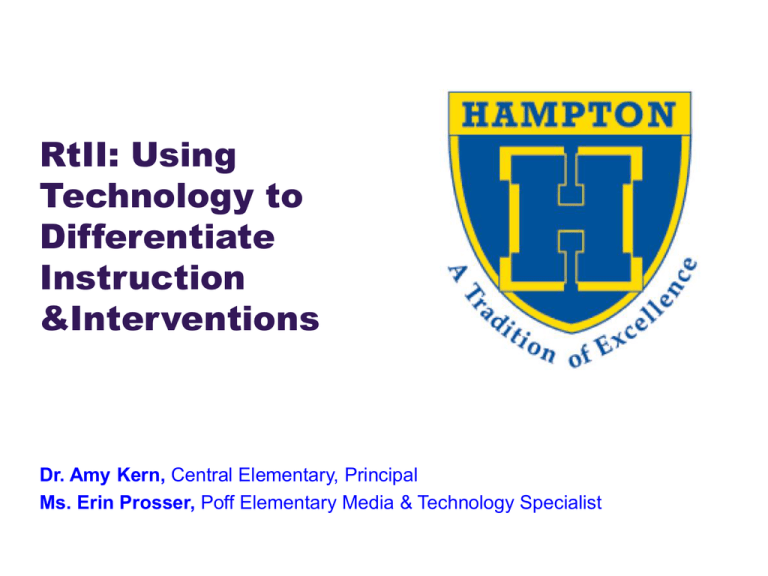
RtII: Using Technology to Differentiate Instruction &Interventions Dr. Amy Kern, Central Elementary, Principal Ms. Erin Prosser, Poff Elementary Media & Technology Specialist Session Goals 1. 2. 3. 4. 5. Understand the Response to Instruction and Intervention (RtII) model Conceptualize a 3 Tier Model of Service Delivery Data Teams Role and Responsibilities Using Data to Create Goals and Action Plans Web Based Programs and Tools that assist in accomplishing goals What is Response to Instruction & Intervention (RtII)? • A comprehensive, standards-aligned strategy that enables early identification and intervention for students needing additional opportunities to learn high level content while providing benchmark students the opportunity to enrich and “grow” their skills and talents. • An alternate to the discrepancy model for the identification of students with learning disabilities. RtII Management: Teams… • Review School-wide performance data • Prescribe instructional or behavioral interventions for students based on intensity of identified needs. • Set short and long term goals for the school and students to progress toward benchmark or standards. • Group all students via level of intervention based on student performance data. • Monitor students’ progress toward established goals and benchmarks. • Adjust interventions based on student performance data. Response to Intervention Framework Data Team Meetings Study Island Benchmarking Benchmarking • Gives teachers a snapshot of student proficiencies in relation to state standards • Give teachers and administrators valuable diagnostic information that can be used to guide classroom instruction Study Island Benchmarking Sample Grade-Level Goals: Reading Goals: 1. Improve understanding of fictional and nonfictional texts. 2. (PSSA) Increase open-ended responses by 10% age points 3. R.B.2 Increase understanding of devices in fictional/nonfictional texts Instructional Strategies: 1. Use Study Island, RAZ-Kids or Education City to increase fluency and comprehension and improve vocabulary. 2. Use Glogster or Digital Storytelling to continue to provide openended opportunities to strengthen ability to write short answer question. Model transfer to math problems. 3. R.B.2 Utilize Study Island to create lessons on “Understand literary devices in fictional and nonfictional texts”. Create post tests to determine proficiency and re-teaching where necessary. Grade-Level Goals: Math Goals: 1. Increase open-ended responses by 10% age points. 2. M.B.1 and .2 Increase # of correct responses to measurement questions by 10% 3. M.D.1 and .2 Provide increased instruction using algebraic concepts of patterns, functions, symbols, tables and graphs Instructional Strategies: 1. Use Digital Storytelling, Inspiration, Education City, or Study Island to provide students with more examples of open ended questions in instruction and on assessments; teach use of graphic organizes to facilitate complete answers. 2. M.B.1and .2 Use iPad apps to provide opportunities for students to become increasingly familiar with and utilize metric measurement. Use Study Island to identify strategic lesson plans related to measurement. Create post test to determine proficiency. 3. M.D.1 and .2 Use Study Island to identify strategic lesson plans that address these concepts. Enter: Grade 5 and “Table and Graphs” , “Functions and symbols”, and “Algebraic Patterns” Benefits of Tier 1 • Promotion of evidence-based instruction on a whole-class, whole-school level • Systematic identification of non-responders (not just teacher referral) Teachers speak common language Reduces “waiting” for referral • Eventual focusing of resources on fewer students at Tiers 2 and 3 Tier 2: Interventions for Some Students • Students receive additional academic and behavioral support to successfully engage in the learning process • Increased Time and Opportunity to Learn: Supplemental small group instruction in addition to: • Use of standard protocol interventions • More frequent Progress Monitoring (every other week) Tier 2: Interventions for Some Students • In addition to core instruction – May include enhanced core instruction or supplemental programs • Use of standard protocol interventions • Scientifically research-based interventions – Academic – Behavioral • Specialists may provide strategic instruction in general education classroom or in homogeneous skill groups • • • • Increased opportunity to learn Increased Instructional time Small group instruction Increased Assessment – Data collection and analysis twice per month – Data-based decision making Tier 2: Potential Outcomes • Responders – Move to Tier 1 – Continue tier 2 Intervention • Non-responders – Adjust instruction and continue Tier 2 intervention – Move to Tier 3 intervention Tier 3: Interventions for a Few Students • Intensive instruction • Use of standard protocol interventions • Supplemental instructional materials for specific skill development • Small intensive, flexible groups • Additional tutoring • Weekly progress monitoring Tier 3: Instructional Strategies • Increased direct instruction time • More frequent progress monitoring (once/week) • More time on task • Core curriculum and intensive intervention • More immediate and corrective feedback • More opportunity to respond • Functional behavior analysis (FBA), Behavioral Intervention Plan (BIP) Tier 3: Potential Outcomes • Responders – Move to Tier 2 – Continue Tier 3 intervention • Non-responders – Adjust instruction and continue Tier 3 intervention – Refer for special education evaluation What is Study Island? • Designed to help students master the content specified in state and Common Core Standards • Provides quality academic support and practice with immediate feedback and built-in remediation • Offers actionable, real-time assessment data • Ideal for self-paced or teacher-guided instruction Grade Level Data Meeting Agenda Learning Support Student Roster Update Reading Tier 3: Intensive Students Progress Monitoring Differentiated Instruction: Classroom and Support Assessments and Report Card Grade Determine continued placement Tier 2: Strategic Students Progress Monitoring Differentiated Instruction: Classroom and Support Assessments and Report Card Grade Determine continued placement Tier 1: Other students Classroom Progress Monitoring Enrichment Math Tier 3: Intensive Students Progress Monitoring Differentiated Instruction: Classroom and Support Assessments and Report Card Grade Determine continued placement Tier 2: Strategic Students Progress Monitoring Differentiated Instruction: Classroom and Support Assessments and Report Card Grade Determine continued placement Tier 1: Other students Classroom Progress Monitoring Enrichment Behavior RtII Advantages • Focus shifts from who is eligible to concerns about providing effective instruction • Identification is not dependent on teacher referral • Allows students to receive intervention immediately upon identified need • Student’s referral includes data indicating how the student has responded to interventions • Promotes unity of special ed. and general ed. – a seamless system RtII Advantages (continued) • Special education may not be the only alternative intervention available • Sets standard for assessment that is meaningfully related to student outcomes • Question for special education evaluation shifts from Yes/No decisions (Is the student eligible?) to what type of intervention results in change? • Links IDEA and NCLB around improved achievement and accountability for ALL students Hampton Township School District RtII Flowchart Hampton Township School District Response to Instruction and Intervention (RtII) Flowchart Universal Screening Considerable need- Team proceeds to Tier 2 th Core Team Date Review th ≤20 -≥11 percentile Tier 1 Intervention in the Classroom Significant Progress, Intervention Discontinued No response Supplemental/Targeted Small Group Instruction 3x/wk Significant need- Team proceeds to Tier 3 ≤10th percentile Tier I: minimally 4-6 weeks Adequate Progress, Continue Intervention Tier 2: minimally 9-12 weeks Progress Monitor Monthly Core Team Review 4x/wk Process Response to Tier 2, Monitor and move to Tier 1 No Response (At least 4 data points) Moderate Progress, Continue Intervention Change Intervention No Response (At least 4 data points) Intensive/Targeted Small Group Instruction 4x/wk Tier 3: minimally 9-12 weeks Progress Monitor Bi-weekly Core Team Review Process Response to Tier 3, Monitor and move to Tier 2 No Response Special Education Referral Adequate Progress, Continue Intervention Other Web Resources • EducationCity • • AIMS Web Testing Digital Storytelling • Photostory 3 • Raz Kids • • Xtra Math Animoto with iPads • Essential Skills • • Web 2.0 Digital Flip Cameras AReader • Glogster • • Starfall.com • Destination Reading • Abcya.com • Think Central • Wodle.net • World Book • Study Island RtII Foundations • Standards-Aligned System and Assessment – Quality Teaching and Learning: Effective Instruction • Teaming (grade level, department, etc.) – Teacher teams learning, designing and revising instruction and assessment procedures • Formative and Summative Assessment – Data collection, analysis and use • School Organizational Structure – Adjustment of Infrastructure, i.e. flexible scheduling, assignment of teachers • Realignment of Flexible Use Resources – Reading Support, Academic Support, IST, Special Education Study Island Lessons • Teachers can guide students through the program, communicating expectations, and create class assignments • Brief lessons reinforce instructional concepts • Students work through questions using multiple modes of instruction Study Island Reading Assignment Study Island Math Assignment Why Study Island Works? • Built-in crosswalks support the transition to the Common Core • Students receive immediate feedback with question explanations Why Study Island Works? • Teachers receive real-time assessment data • Teacher support tools include lesson plans, instructional videos, and web- and print-resources Study Island Reporting • Generate reports by student, subject, class, grade, or school • Measure progress and identify areas where students are excelling or need extra practice Study Island Reporting Examples: Topic Suggestion Report Study Island Reporting Examples Individual Student Report



